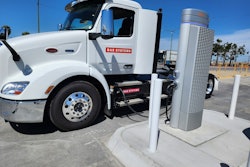Marketing campaigns and regulations often focus on model years. Model year, or MY, seems like such a simple, easily understood term. In writing NACFE’s report on the DOE SuperTruck 2 program, I had to concede that the term MY is, at best, confusing.
The baseline vehicles used for comparison in the DOE’s SuperTruck 1 and 2 program was to be each OEM’s MY 2009 interpretation of an existing aerodynamic model with high sales volume. Each team was to assess their existing sales data and find a suitable candidate spec that represented a significant portion of existing fleet purchases for Class 8 long-haul trucks pulling 53’ dry van trailers. There was a separate effort to determine a representative baseline 53’ trailer’s model year, since that new tractor could be pulling a wide range of older trailers.
The confusion starts because Model Year 2009 actually starts in calendar year 2008. For most companies, Model Year 2009 covers January 2, 2008, through January 1, 2009. So, with the exception of those extremely rare trucks with January 1 birthdays, MY 2009 are really calendar 2008 trucks.
If that was not confusing enough, as the EPA, DOE and the OEMs dove into the creation of the GHG 2011 regulations, it turns out that engines also have their own model year and born-on calendar dates. An engine’s birthday is the moment the crank gets put into the engine during the manufacturing process.
I’m at a loss as to what defines model year electric motors in fuel cells and battery electric trucks. I’m not in that regulatory loop anymore, but I expect somewhere in a regulation there a vague enough definition that the OEMs can stamp a unique date on the powertrain.
These variety of dates for the same vehicle exist because we need to know that a vehicle model is newer than the one we previously bought, and that new rules probably apply as well.
But it gets confusing, even to those in the industry.
Imagine going to get your first driver’s license and telling the DMV that you’re 17 years old according to your model year, but 16 according to your birth certificate. Or for the older generation, imagine talking to the Medicare and Social Security groups about when you qualify.
The history of the term model year came out of a need to differentiate new product offerings and excite buyers. Henry Ford’s first production vehicles likely did not have model years as there were very few significant changes on an annual rate. One automotive historian, according to The Detroit News, asserts that new model years showed up in the 1910 decade because vehicles were bought by farmers who harvested crops in the fall and had cash for new purchases then. Marketers wanted to capitalize on that cash, so enticed buyers into sales with new products.
What really energized model years is that Ford’s competitors like GM’s Alfred Sloan started offering new features and styling on a somewhat regular schedule. Planning for these new vehicles started impacting factories. The automobile manufacturers had to regularly schedule retooling for the new models, causing factories to pause production to switch over to the newer designs. In time, the industry evolved to having new model offerings more or less annually.
Model years were not standardized. According to The Chicago Tribune, the lack of uniformity in the marketplace led president Franklin Roosevelt in 1935 to release an executive order standardizing the model year to start in the fall to encourage the Depression Era public to buy new cars and help increase employment.
While I can’t find the specific executive order, consensus of the sources I located seems to conclude the new model year in 1936 started October 1, 1935.
Vehicle Identification Numbers (VINs), didn’t start until 1954 and were not standardized until 1981, when the National Highway Traffic Safety Administration required all on-road vehicles to have a 17-character VINs. The DOT instructed manufacturers that the VIN has to include the “Model year — the year used to designate a discrete vehicle model, irrespective of the calendar year in which the vehicle was actually produced, provided that the production period does not exceed 24 months.”
Does your head hurt yet?
Along comes the GHG 2011 regulations, with the Definitions sections §1036.801 and §1037.801 describing model year as:
Model year means the manufacturer’s annual new model production period, except as restricted under this definition. It must include January 1 of the calendar year for which the model year is named, may not begin before January 2 of the previous calendar year, and it must end by December 31 of the named calendar year. Manufacturers may not adjust model years to circumvent or delay compliance with emission standards or to avoid the obligation to certify annually.
In layman’s terms, the Model Year 2025 starts January 2, 2024 and can end December 31, 2025.”
Clear as mud, yes?
In practice, I believe annual government reporting requirements reinforce that the MY2025 ends on January 1, 2025.
Industry, government and the public have knowingly or unknowingly conspired to make the term model year challenging. It’s a marketing term that evolved into a regulatory one, with all the legal jargon baggage that can entail.
In writing NACFE’s report on the DOE SuperTruck 2 accomplishments, with the advice and insistence of the five teams, NACFE removed most of the redundant explanations that MY 2009 meant calendar year 2008 built trucks. It sufficed that there were baseline vehicles.
While that clarification helped us finish the NACFE SuperTruck 2 report, it does not help the ongoing discussions of new regulations such as GHG Phase 3, the Advanced Clean Truck rule, and other rules.
Model year may be obvious to some but not understood by all. Manufacturers are building MY2025 trucks today, and have been since January 2, 2024. Additionally, customers are right now spec’ing and ordering MY2026 trucks to be built in 2025.
A year may or may not matter to some, but to others it can be critical.
Hopefully this explanation and history helps.













